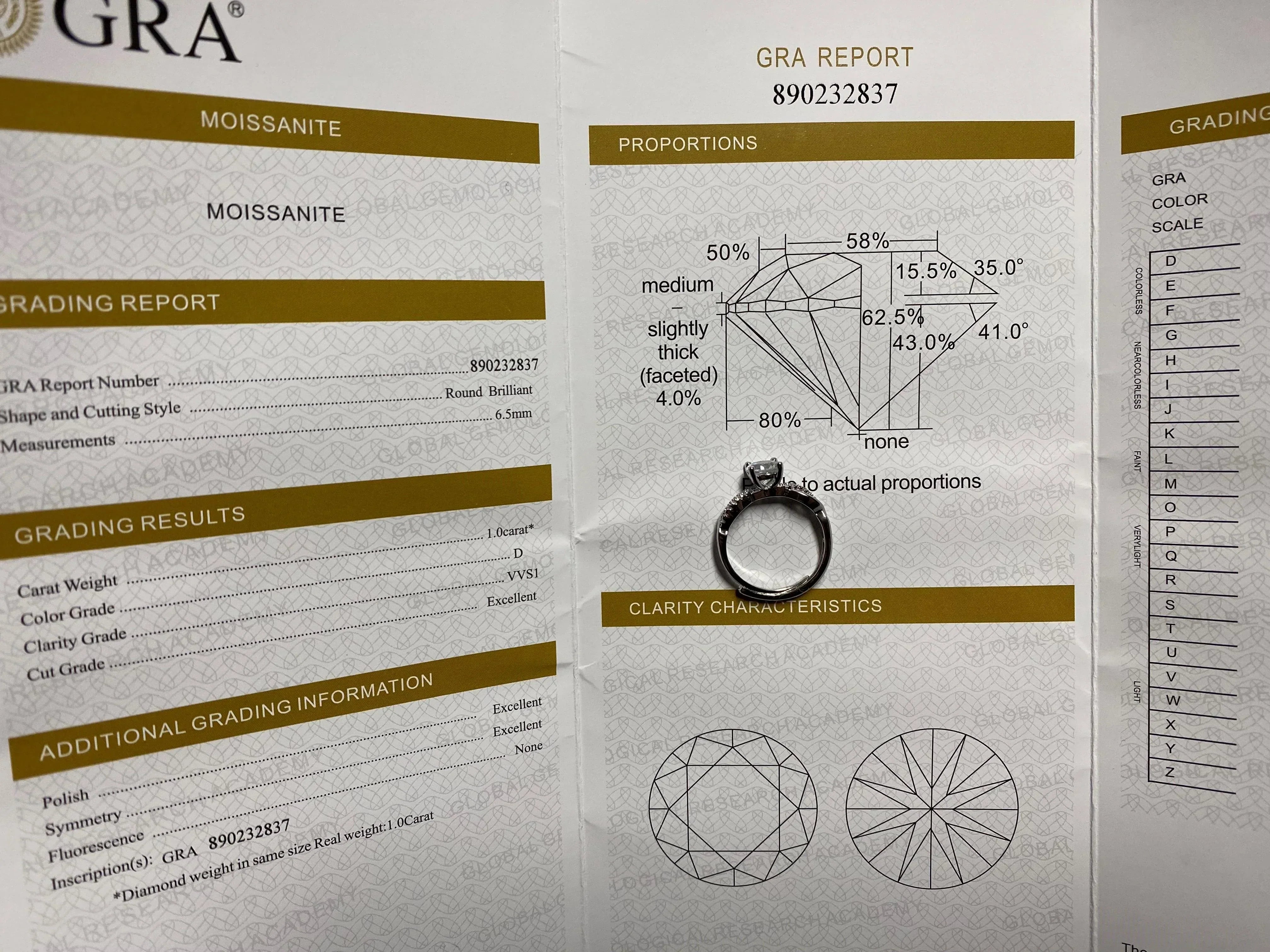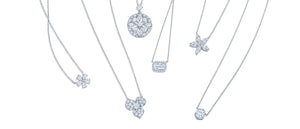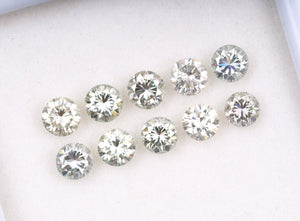This newcomer diamond in the world of gemstones is called GRA moissanite and has become quite popular.
With fantastic brilliance and a cut that rivals a diamond, the status of moissanite as a gemstone of extraordinary durability and a relatively low cost has definitely earned its place among the popular materials.
GRA (Gemological Research Association) reports show that, as the popularity of this beautiful stone rises, so does the need for its certification.
As moissanite becomes increasingly popular due to its luster and low cost, the market for fake certificates has also expanded.
When the demand grows, the counterfeits become more visible and draw the attention of customers they fool. All this adds even more pressure for the buyers to learn the proper techniques for verifying the actuality of a GRA Moissanite Report.
So, how do you know if a GRA moissanite report is real or fake? In this article, I will explain what moissanite is, what the role of GRA reports is, and how to safely identify fraudulent certificates.
What is Moissanite?

Moissanite, which was first discovered by French scientist Henri Moissan back in 1893 in a meteor crater, was initially mistaken for a diamond due to its brilliance as well as its hardness.
Moissanite, and not diamond, is made from silicon carbide, which is one of the most recognizable materials of white light emitting diodes, using the superior optical abilities and durability of silicon carbide.
Nowadays, moissanite is laboratory-grown and it is quite amazing for its intense fire and brilliance which in many cases outshines diamonds.
The feature of its affordability and similarity in appearance to diamonds make it a popular choice for engagement rings and fine jewelry.
Despite its very close resemblance, moissanite differs in some features: it displays a higher brilliance, a 9.25 hardness on the Mohs scale, and a sparkling rainbow-like fire.
Moissanite's popularity has surged due to its emergence as a cost-effective and fashionable alternative to diamonds, thus leading to high retinue through the GRA report.
What is a (Global Gemological Research Association Institute)GRA Moissanite Report?

You will ask “What is a GRA Moissanite Report?”. Well, let us explain, the GRA or Gemological Research Association is a gemological laboratory that provides grading reports for gems, among them is moissanite.
These reports specify on the quality and genuine nature of the gemstone and thus give the consumer confidence in the product.
So, what is a GRA diamond? A GRA-certified check report often features identification of the gemstone in which the experts establish that it is moissanite, and not any other material such as the CZ or synthetic diamond.
The following parameters are also mentioned in the report:
- The carat weight in which the actual weight of the gemstone is given. As oftenly carats are misleading because the weight does not necessarily translate to the size of the gemstone.
- The cut grade through which there is an evaluation of the quality and manner by which the cut of the stone enables it to reflect light.
- The color grade, now in this Moissanite comes in various colors, and this grading determines whether the stone is colorless, slightly coloured or coloured.
- The clarity grade in which they make assessment of internal imperfection or inclusion and external characteristics of the stone.
- The check on the proportion of the stones, where the measures of the stone and how some of these measures affect the overall outlook of the gemstone.
- Lastly there is a mention of a laser inscription. Which are visible on some stones and are considered a good ID proof.
This report is useful for buyers because it ensures them that the product that they are getting – moissanite, corresponds to definite requirements. Nonetheless, looking at the present reports where cases of fake reports are on the rise, it becomes important to know how to spot a fake GRA report.
How to Determine if a GRA Moissanite Report is Fake?

As there has been an increase in fake gemstones and certification reports, therefore it is important to verify any GRA moissanite report you get.
Here are critical steps to thoroughly evaluate and verify the authenticity of a GRA moissanite report. Following them will ensure you can confidently perform a GRA certified check to distinguish between a genuine and a counterfeit one.
1. Check the Report with GRA

The easiest and quickest method of determining the credibility of a GRA moissanite report is to cross-check the report with the Gemological Research Association. A majority of the genuine reports are assigned a special reference number which can be confirmed that it is GRA certified on their website . Here’s how:
- Locate the Report Number: The serial numbering system is an important one and every GRA report should have its own serial number. That is usually placed on the right hand top corner of the certificate.
- Visit the GRA Website: Open the GRA’s official website and go to the report verification page section.
- Input the Report Number: To execute the stronger verification of the GRA report, input the serial number in the verification tool.
- Match the Details: If the report is real, you should have all the information provided in the website on your physical or digital report. This may consist of the type of gemstone, the carat weight and the grading detail or otherwise.
If it's GRA certified meaning it is a real deal or if the serial number doesn’t work or if it fails to show the details or any specific report is not what is provided, then it might be an imitation.
2. Examine the Report’s Quality

There are certain features to be expected in a genuine GRA report and they include; A report should have professional and high quality work done on it. Pay close attention to:
- Paper Quality: Original GRA moissanite reports are composed typewritten, on bond quality paper, which sometimes possess an obvious texture or water mark which it is hard to fake.
- Hologram Security Feature: Some of the authentic reports contain a hologram or any other feature that must be very hard for the forgers to imitate.
- Font Consistency: Review the formation style, the size of the characters, as well as, the style and spacing of the entire paper. Such things as hitches, gaps, and variations might signify something of concern.
- Grammar and Spelling: Typing mistakes, incorrect spelling mistakes and wrong grammar are commonly found in the forged reports which should act as a warning bell.
3. Cross-Check with the Seller

When purchasing a moissanite ring, it is essential to work with a reputed seller. Most of the fake sellers out there will give a pseudo GRA report in an attempt to deceive buyers into believing that they are getting higher quality than what they are actually paying for. GrownLeo is one of the most reputed seller for mossanite jewelry.
Always cross-check the reputation of the seller by:
- Reading Reviews: Look for customer reviews and testimonials. In case a seller has been involved in selling fake gemstones or reports, most likely, previous buyers will have left negative feedback.
- Request Documentation: Request more documentation or proof of purchase, such as an invoice or a letter of authenticity from the jeweler. A trustworthy seller will have no problem with this.
- Check Seller's Website: Make sure the seller's website is valid. If possible, call and verify the details of your purchase.
4. Examine the Moissanite Yourself

If you doubt that the GRA report is hype, take your moissanite to any reputable gemologist for an inspection. They will be able to verify whether your stone is moissanite and if it is of the quality mentioned in the report. You can conduct some straightforward tests yourself at home to examine the stone:
- Fire test: Moissanite is highly dispersive and reflects more colorful light flashes. Observe the fire and brilliance of the stone using a jeweler's loupe. It is probably not moissanite if it does not have that signature sparkle resembling a rainbow.
- Hardness test: Moissanite is almost as hard as a diamond on the Mohs hardness scale. If you are taking a material softer than moissanite, you scratch a surface with, for instance, glass. See whether it leaves any marks. Be careful when handling this test, for it may potentially damage the stone.
The one optical property of moissanite is double refraction. While observing the stone from different angles, it has to reflect a double image of facets.
5. Engage Only with Reputable Sellers and Jewelers

The most efficient way to avoid counterfeit GRA reports is to buy moissanite only from a reputable seller or certified jeweler. Well-established retailers don't risk their reputation by selling counterfeit gemstones or certificates. For added assurance, consider purchasing moissanite rings from these trusted sources.
How to Work with Trusted Sellers?
Check Out the Seller: Do your homework on the seller before buying. Check for online reviews, testimonials, legal disputes, or customer complaints.
Get a Second Opinion: If you are somehow in doubt over the genuinity of the stone or the GRA report, show the stone to an independent gemologist or get it appraised by a local jeweler.
Request Additional Documentation: Also, ask the seller whether there are other certificates, warranties, or appraisals available about the gemstone in question. Vendors with a good reputation will usually be able to make these available on request.
6. Pricing Analysis: Beware of Deals Too Good to Be True

Perhaps one of the easiest red flags when identifying a fake GRA report is an unusually low price for a high-quality moissanite stone. While moissanite has proved to be much more affordable than diamonds, high-quality stones still hold their value in the market.
Price Analysis Steps
Compare Prices: Compare the price of the moissanite against other similar stones sold by reputable jewelers. If the price is significantly lower, be cautious.
‘Not Normal’ Discounts: Extreme and sometimes random discounts are also possible hints that a gemstone or a certificate is artificially made. Counterfeiters often use very heavy discounts to tempt buyers into impulse purchases.
7. Laser Inscription Check the Gemstone

This is usually a serial number or identifier that correlates to the serial number on your GRA report. Many Moissanite gemstones that the GRA grades carry a laser inscription on the stone. If your gemstone bears a laser inscription, you can examine it using a jeweler's loupe or magnification tool.
How to Check for Laser Inscription?
Location of the Inscription: Most laser inscriptions are on the girdle- the outer edge of the gemstone. They are tiny and must be magnified to be seen clearly.
Serial number: The serial number on the stone should correspond with the one given in your GRA report. In any other case, this is undoubtedly a fraud.
Quality of the Engraving: An authentic laser engraving should be clear, sharp, and easily readable with magnification. The writing should not be sloppy or uneven; otherwise, it will be a forged one.
If you still are not able to know, why should you moissanite over diamond, then here is our blog on Moissanite vs Diamonds - Complete Comparison
Conclusion
In the current market, where the demand for moissanite continues to rise, knowing how to identify fake GRA reports is essential.
By comparing it with the report in the GRA and testing the certificate's quality, you can avoid a scam and buy from reliable sellers.
Moreover, properly examining the stone and being wary of the price will help one obtain real moissanite with a genuine certification.
In short, while moissanite is an exceptional gemstone and with a correct GRA report it is absolutely beautiful and highly recommendable as a jewelry gem.
If you are a moissanite enthusiast, do not let counterfeiters spoil your joy—be careful and well-informed, and then you can get the pleasure from genuinely non-pareil moissanite.






